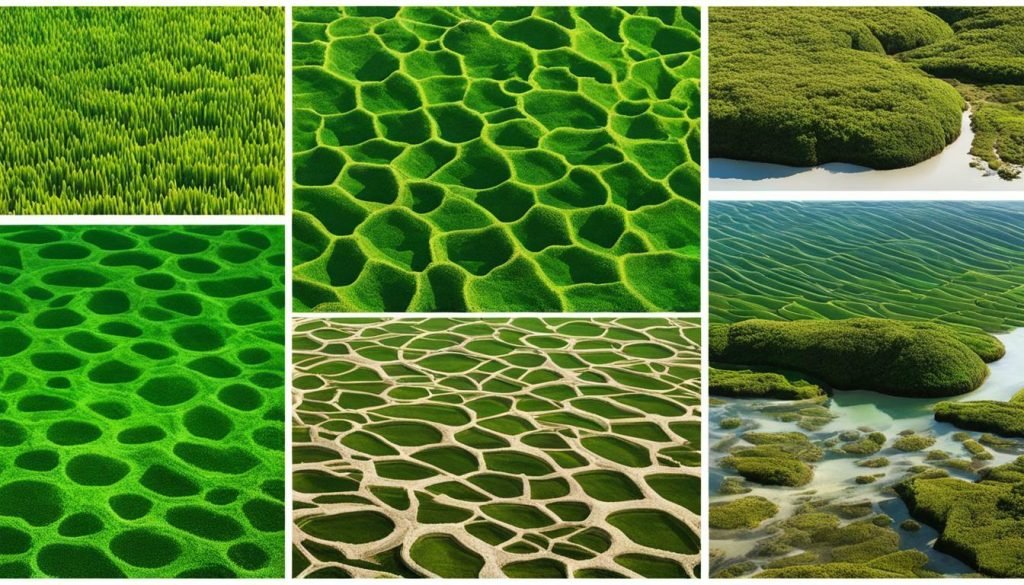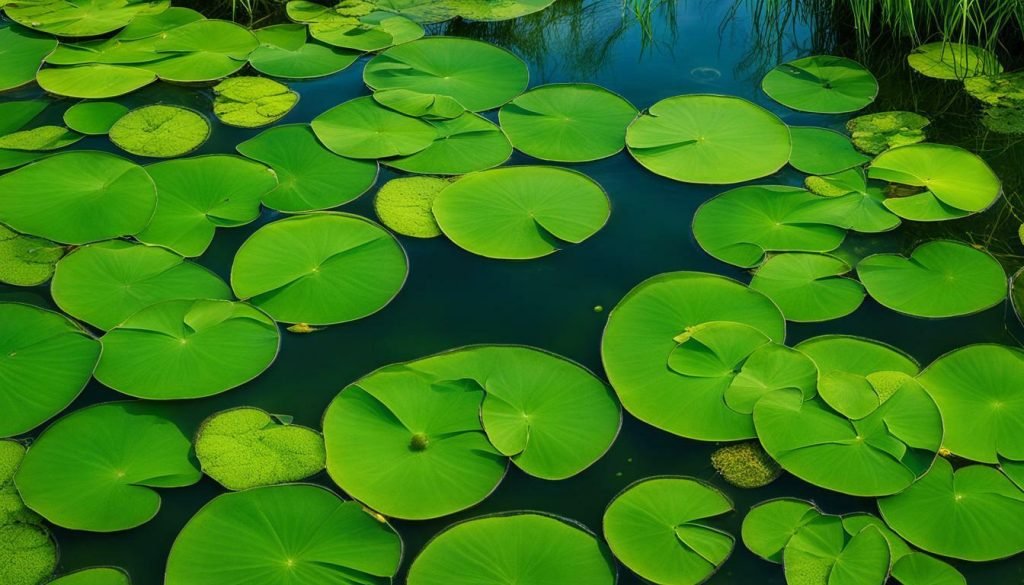Algae growth is a common problem for pond keepers and dam owners in South Africa, but with the right strategies, you can effectively prevent it. Algae can deplete oxygen levels and obscure the beauty of the water. To keep your water bodies clean and algae-free, it’s essential to take proactive measures. One effective strategy for preventing algae growth is to use a pool cover. Pool cover benefits include preventing sunlight from reaching the water, which can limit the growth of algae. Additionally, a pool cover can also help to keep out debris and other organic matter that can contribute to algae formation. By using a pool cover, you can effectively reduce the risk of algae growth and maintain the beauty and health of your water bodies.
Key Takeaways
- Understanding the different types of algae is crucial for effective prevention.
- Adding plants to your pond can help absorb the nutrients that algae feed on.
- Water treatments, such as AlgaeControl™, can be used to control existing algae problems.
- Feeding high-quality fish food reduces the nutrients available for algae to thrive.
- Dam owners can implement strategies like nutrient reduction, aeration, probiotic treatments, and the use of floating islands.
Understanding Algae and its Types
To effectively prevent algae growth, it is important to have a good understanding of the different types of algae and their characteristics. Algae are primitive plants that use photosynthesis to grow and produce oxygen. They can be found in various water bodies, including ponds and dams in South Africa. By understanding the different types, you can take appropriate measures to prevent their growth and maintain the beauty of your water.
There are two main types of algae commonly found in ponds: green water and string algae. Green water is composed of single-celled organisms that can pass through filters, resulting in water that appears green and cloudy. String algae, on the other hand, grows in long strands that can adhere to rocks, waterfalls, and other surfaces. It creates a stringy and slimy appearance, often causing aesthetic concerns for pond keepers and dam owners.

Preventing the growth of algae involves implementing appropriate strategies for each type. For green water algae, options include adding plants that absorb excess nutrients and using water treatments specifically designed to control its growth. String algae, on the other hand, can be managed by manually removing it and incorporating plants that provide shade to limit its exposure to sunlight.
Understanding the characteristics of algae and their growth patterns is the first step towards effective algae prevention. By identifying the types of algae in your water body and implementing the right strategies, you can achieve clean and algae-free water, enhancing the overall appeal and health of your pond or dam.
Adding Plants to Prevent Algae Growth
Adding the right plants to your pond can be a highly effective method of preventing algae growth. Plants play a crucial role in reducing algae by absorbing the nutrients that algae feed on. There are different types of plants that you can incorporate into your pond to keep the water clean and clear.

Oxygenating plants are a great addition to your pond as they release oxygen into the water, which helps to maintain a healthy environment. These plants, such as Anacharis and Hornwort, grow on the surface of the water and act as natural filters, absorbing excess nutrients that algae thrive on.
Floating plants, such as Water Lilies and Water Hyacinths, provide shade and help to control the amount of direct sunlight reaching the water. This reduces the opportunity for algae to grow and multiply. Additionally, these plants add aesthetic appeal to your pond.
Marginal plants
Another option to consider is adding marginal plants around the edges of your pond. These plants, like Marsh Marigolds and Pickerel Weed, absorb excess nutrients from the water and provide shade to control algae growth. They also create a beautiful border for your pond.
Incorporating a plant filter system can also be a beneficial strategy. This involves creating a separate filtration pond or channel where you can grow fast-growing plants like Cattails and Water Iris. These plants act as a natural filter, absorbing nutrients from the water and preventing them from reaching your main pond, thus reducing the potential for algae growth.
By carefully selecting and maintaining the right plants in your pond, you can significantly reduce the occurrence of algae growth and enjoy clear, healthy water. However, it is important to remember that proper maintenance, including regular pruning and removal of decaying plant matter, is essential to keep your pond in optimal condition.
Water Treatments for Algae Control
If you already have algae in your pond, there are water treatments available to help you control and prevent further growth. Green water and string algae can be treated with products like AlgaeControl™ from TetraPond. It is important to follow the dosage instructions for these treatments to ensure effective results.
Water treatments for algae control can be a valuable tool in maintaining the health and clarity of your pond or dam. These treatments work by targeting and neutralizing the algae, preventing it from growing and spreading. By using the right water treatment, you can effectively control and eliminate algae, allowing for clear and algae-free water.

The Benefits of Water Treatments
- Prevent algae growth: Water treatments specifically target and inhibit the growth of algae, ensuring your pond or dam remains free from unsightly green water or string algae.
- Improve water clarity: By eliminating algae, water treatments can improve the clarity of the water, allowing you to fully enjoy the beauty of your pond or dam.
- Promote a healthy ecosystem: Algae can deplete oxygen levels, leading to poor water quality and potentially harmful conditions for fish and other aquatic life. Water treatments help restore balance to the ecosystem, ensuring a healthy environment for all living organisms.
When using water treatments, it is essential to carefully follow the instructions provided by the manufacturer. This will ensure that you use the proper dosage and achieve the desired results without causing harm to your pond or dam.
| Water Treatment Product | Features |
|---|---|
| AlgaeControl™ | – Specifically formulated to combat green water and string algae – Easy-to-use liquid formula – Safe for fish, plants, and wildlife |
| Algaway 5.4™ | – Effectively controls green water, blanketweed, and string algae – Fast-acting formula – Safe for fish and plants |
| GreenClean™ Liquid Algaecide | – Kills and controls various types of algae – Non-copper based formula – Suitable for ponds with fish and plants |
By incorporating water treatments into your algae prevention routine, you can effectively control and eliminate algae growth, ensuring a clean and healthy pond or dam. Remember to choose a water treatment specifically designed for the type of algae you are dealing with and follow the instructions carefully for optimal results.
Feeding High-Quality Fish Food for Algae Prevention
A simple yet effective way to prevent algae growth in aquariums is by feeding your fish high-quality food. When fish food contains a balanced mix of essential nutrients, it is easier for your fish to digest and absorb, resulting in less waste being produced. This means that there are fewer nutrients available in the water for algae to feed on, reducing the likelihood of algae growth.
High-quality fish food is specifically formulated to meet the nutritional needs of your fish. It contains a blend of proteins, vitamins, and minerals that promote healthier fish and contribute to their overall well-being. By providing your fish with a nutritious diet, you not only support their growth and vitality but also help maintain a clean and algae-free environment in your aquarium.
When choosing fish food, look for options that are free from fillers and artificial additives. It is recommended to opt for reputable brands that prioritize the quality of their ingredients. Feed your fish the appropriate amount of food based on their size and dietary requirements, ensuring that they consume all the food within a few minutes. Overfeeding can lead to excess nutrients in the water, which can contribute to algae growth.

A well-balanced diet, consisting of high-quality fish food, helps maintain water clarity and quality, providing a healthy living environment for your fish. As algae growth is closely linked to nutrient levels, feeding your fish a nutrient-rich yet easily digestible diet is an effective preventive measure. By keeping the water conditions optimal for your fish, you can minimize the risk of algae taking hold in your aquarium.
Algae Prevention for Dam Owners
For dam owners, preventing algae growth requires a targeted approach that takes into account the specific challenges of maintaining a large water body. With their size and open nature, dams are more susceptible to algae problems compared to smaller ponds. However, there are effective strategies and methods that can be employed to keep algae at bay and maintain clean and healthy water.
One key aspect of algae prevention for dam owners is understanding the different types of algae and their causes. String algae, which looks like hair and grows in clear water, and planktonic algae, which turns the entire water column green, are common types found in dams. By identifying the specific algae type, dam owners can better address the root cause of the problem.
Nutrient reduction is a crucial step in combating algae growth. Nutrients can enter dams through runoff, fertilizers, and organic materials, fueling algae growth. To minimize nutrient levels, promoting the growth of aerobic bacteria is essential. These bacteria consume organic sludge and extract nutrients from the water, effectively reducing the food source for algae.
There are several effective methods for algae prevention in dams. Aeration is a powerful tool that boosts oxygen levels in the water, supporting the growth of beneficial bacteria that outcompete algae. Probiotic treatments, which involve introducing “good” microbes into the water, aid in the consumption of sludge and reduction of nutrients. Additionally, the use of floating islands can be highly effective. These buoyant mats planted with vegetation act as natural filters, absorbing phosphorous from the water and providing a habitat for bacterial populations.
To summarize, preventing algae growth in dams requires a proactive and multifaceted approach. By understanding the specific challenges faced by dam owners, such as nutrient buildup and the presence of different algae types, targeted strategies can be implemented. Aeration, probiotic treatments, and the use of floating islands are powerful tools in maintaining water quality and preventing unsightly algae growth in dams.
| Algae Prevention Tips for Dam Owners |
|---|
| Identify the specific type of algae present in the dam. |
| Reduce nutrient levels by promoting the growth of aerobic bacteria. |
| Implement aeration systems to increase oxygen levels and support beneficial bacteria growth. |
| Consider probiotic treatments to aid in the consumption of sludge and nutrient reduction. |
| Use floating islands to absorb phosphorous and provide habitat for bacterial populations. |
Conclusion
Preventing algae growth in South Africa’s ponds and dams is achievable with the right knowledge and strategies in place. By understanding algae, adding plants, using water treatments if necessary, and reducing nutrients, you can maintain clean and algae-free water bodies. Regular maintenance of ponds and dams is also crucial in preventing algae growth. This includes skimming the surface for debris, checking for any leaks, and ensuring proper water circulation. In addition, brushing your pool walls and floors can help prevent algae from taking hold in those areas. With consistent effort and the right techniques, keeping algae at bay in South Africa’s water bodies is entirely possible. Another effective method for preventing algae growth in ponds and dams is to invest in a quality pool cover. A pool cover can help to block out sunlight, which algae need to thrive, as well as prevent debris from entering the water. When considering the implementation of a pool cover, it’s important to research pool cover cost per square foot to determine the most cost-effective option for your specific water body. Ultimately, by combining multiple preventive measures and staying proactive in maintenance, South Africa’s ponds and dams can remain free from algae.
Algae growth is a common problem for pond keepers and dam owners in South Africa. It can negatively impact the oxygen levels in the water and obscure the beauty of the aquatic environment. However, with the implementation of effective preventive measures, you can mitigate the growth of algae and ensure the health and aesthetic appeal of your water bodies. Implementing proper pond and dam maintenance, such as regular cleaning and aeration, can help prevent the overgrowth of algae. Additionally, using natural or chemical algaecides can also be effective in managing and controlling algae growth. Furthermore, incorporating pool cover safety tips, such as ensuring proper filtration and reducing nutrient levels in the water, can further contribute to the overall health and appearance of the water bodies.
To begin, it is crucial to understand the nature of algae. Algae are primitive plants that rely on photosynthesis for growth and oxygen production. By familiarizing yourself with the different types of algae, such as green water and string algae, you can tailor your preventive approach accordingly.
Adding plants to your pond is one of the most effective strategies for algae prevention. Plants have the ability to absorb the nutrients that algae feed on, thus reducing their growth. Consider introducing oxygenating plants on the surface of your pond to keep the water clean, floating plants to provide shade and control sunlight exposure, and marginal plants around the edges of the pond to absorb nutrients and offer additional shade.
In cases where existing algae problems persist, water treatments can be employed. Products like AlgaeControl™ from TetraPond offer reliable solutions for combatting green water and string algae. However, it is important to carefully follow the dosage instructions provided to ensure effective results.
Feeding high-quality fish food can also play a role in algae prevention. By opting for fully-digested fish food, you minimize the nutrients available for algae to thrive on, resulting in a cleaner aquatic environment.
For dam owners, a thorough understanding of the different types of algae and their causes is essential. Identifying the specific algae species and determining the contributing factors allows for targeted preventive measures. Nutrient reduction is a cost-effective approach that can be achieved by promoting the growth of aerobic bacteria, which consume organic sludge and extract nutrients from the water.
To combat algae in both ponds and dams, aeration, probiotic treatments, and the utilization of floating islands have proven to be highly effective. Aeration increases oxygen levels in the water, fostering the growth of beneficial bacteria. Probiotic treatments involve introducing “good” microbes that aid in sludge consumption and nutrient reduction. Floating islands, consisting of buoyant mats planted with vegetation, help draw phosphorous from the water and provide a habitat for bacterial populations, thus reducing nutrient levels.
In conclusion, maintaining clean and algae-free water bodies in South Africa requires a holistic approach. By incorporating the knowledge gained about algae, implementing plant-based prevention strategies, utilizing water treatments when necessary, and reducing nutrient levels through various methods, you can successfully prevent algae growth and enjoy the beauty of your ponds and dams for years to come. Additionally, considering the pool cover cost in South Africa is also important when discussing methods for preventing algae growth. Investing in a good quality pool cover can help to minimize the accumulation of organic matter and reduce sunlight exposure, both of which contribute to algae growth. By combining these strategies, you can effectively maintain clean and algae-free water bodies in South Africa.
How can I prevent algae growth in my swimming pool in South Africa?
To prevent algae growth in your swimming pool in South Africa, invest in topnotch swimming pool covers. These covers help to block out sunlight and reduce the growth of algae. Additionally, regular cleaning, proper water circulation, and chemical balancing can also help keep algae at bay.
FAQ
What is algae and why is preventing its growth important?
Algae are primitive plants that can deplete oxygen levels and obscure the beauty of water. Preventing algae growth is important to maintain water quality and aesthetics.
What are the different types of algae found in ponds and dams?
There are two main types of pond algae: green water, which consists of single-celled organisms, and string algae, which grows in long strands and can adhere to rocks and waterfalls. In dams, string algae looks like hair and grows in clear water, while planktonic algae turns the entire water column green.
How can adding plants help prevent algae growth?
Plants absorb the nutrients that algae feed on, reducing their growth. Oxygenating plants on the surface of the pond help keep the water clean, while floating plants provide shade to control the amount of direct sunlight reaching the water. Marginal plants can be planted around the edges of the pond to absorb nutrients and provide shade as well.
Are there any water treatments available to control algae?
Yes, products like AlgaeControl™ from TetraPond can be used to treat green water and string algae. It is important to follow the dosage instructions for these treatments.
How does feeding high-quality fish food help prevent algae growth?
Fully digested food leaves fewer nutrients for algae to feed on, reducing their growth. Feeding high-quality fish food can help discourage algae growth in aquariums.
What are some strategies for preventing algae growth in dams?
Dam owners can reduce nutrients in the water by promoting the growth of aerobic bacteria, which consume organic sludge and pull nutrients from the water. Aeration, probiotic treatments, and the use of floating islands made of buoyant mats planted with vegetation are also effective ways to combat algae.
